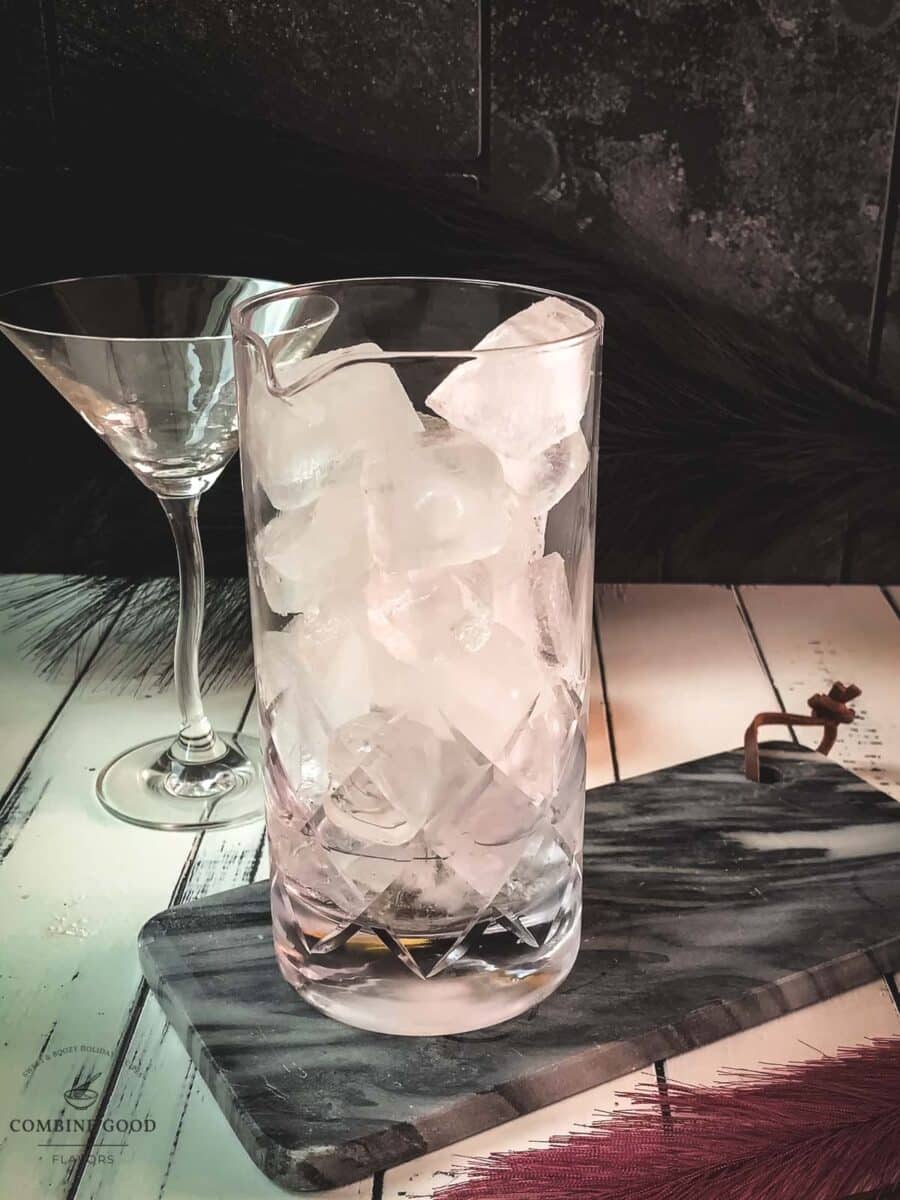Timeless Elegance in a Glass: How to Master the Classic Martini
Hello, my dear cocktail friend! As the end of the year draws near, I thought it would be the perfect time to revisit a true classic—the martini. Timeless, elegant, and oh-so-sophisticated, this iconic cocktail has graced everything from intimate dinner parties to glamorous evenings out. It’s simple in its components yet endlessly fascinating in its variations, making it a staple in every cocktail enthusiast’s repertoire.

But how do you prepare the perfect martini? Stirred or shaken? What about the differences between a classic martini, a dirty martini, or a dry martini?
In this post, I’ll not only share my go-to recipe for the classic martini, but I’ll also explore these variations and the techniques behind them. While many purists swear by stirring in a mixing glass to keep the drink crystal clear and velvety smooth, there are recipes that embrace shaking for a slightly different texture and aeration.
So, let’s get to it! Grab your favorite gin or vodka, a stirring glass (or shaker if you prefer), and a chilled glass. By the end of this post, you’ll not only have the tools to make a martini to your taste but also the knowledge to impress your guests with its fascinating history and variations. Cheers to ending the year with a touch of elegance!
🎥 Video
🥘 Ingredients
- Cubed ice for the stirring glass
- Gin - Plymouth Gin is a top-tier option and a safe choice for anyone exploring classic cocktails.
- Dry Vermouth
- Lemon zest or Olive for garnish
See the recipe card for quantities.
🔪 Instructions
Step 1: Pour the gin and vermouth into a chilled stirring glass.
The chill helps maintain the martini’s crisp, smooth character.


Step 2: Add ice and stir the drink with a bar spoon.
Slide the spoon along the rim of the glass to create a smooth, rotating movement of the ice cubes. This technique ensures the drink is perfectly chilled without becoming overly diluted.


Step 3: Strain the cocktail into a chilled glass.
Place a julep strainer (if you have one) over the stirring glass and pour through a fine strainer into your pre-chilled cocktail glass. This extra step ensures your martini is silky smooth.

Step 4: Garnish and serve.
Choose a slice of lemon zest for a citrusy flair or go classic with an olive. Serve immediately and enjoy this timeless cocktail perfection!

🍸 Variations - Martini, Dry Martini, and Dirty Martini
When it comes to martinis, the devil is in the details. While the ingredients may look similar on paper, the ratios and additions make all the difference, creating unique flavor profiles for each variation. Let’s break it down, so you can confidently mix the perfect martini to suit your mood.
1. The Classic Martini
This is the martini that started it all—elegant, timeless, and oh-so-sophisticated. A traditional martini is made with gin (or vodka, if you prefer) and dry vermouth, stirred over ice until perfectly chilled.
The Ratio: Typically a 2:1 or 3:1 ratio of gin to vermouth.
The Garnish: A lemon twist for brightness or an olive for a savory touch.
The Flavor: Balanced and smooth, with the botanicals of the gin shining alongside the gentle herbal sweetness of the vermouth.
Why You’ll Love It: It’s the cocktail equivalent of a perfectly tailored suit—classic, versatile, and always stylish.
2. The Dry Martini
If you’re all about the gin, the dry martini is your best friend. This version uses significantly less vermouth—or sometimes just a rinse or a mist—to let the gin’s bold botanicals take center stage.
The Ratio: Anywhere from 5:1 to a whisper of vermouth, depending on how dry you want it.
The Garnish: A crisp lemon twist or a classic olive, depending on your preference.
The Flavor: Crisp, clean, and gin-forward, with just a hint of herbal complexity from the vermouth.
Why You’ll Love It: It’s all about the gin, with a no-nonsense approach to cocktail sophistication.
3. The Dirty Martini
Looking for a savory twist? Enter the dirty martini, where olive brine steals the show. This variation adds a splash of brine to the mix, creating a salty, briny flavor that’s completely irresistible for olive lovers.
The Ratio: Similar to a classic martini, but with ½ to 1 ounce of olive brine added for that signature “dirty” taste.
The Garnish: Always olives—bonus points for blue cheese-stuffed ones.
The Flavor: Savory and bold, with the salty brine adding a punch of umami to the gin and vermouth combo.
Why You’ll Love It: It’s like having your cocktail and your bar snack in one glass.

🍸 Choosing Gin & Dry Vermouth
When it comes to martini-making, your choice of gin and dry vermouth can make all the difference. Plymouth Gin is a true classic, known for its smooth, balanced flavor with earthy and citrusy notes. Its versatility makes it a great choice for martinis, Negronis, and gin and tonics. Prefer something bolder? Tanqueray No. Ten, with its bright citrus-forward profile, is another standout, pairing beautifully with a range of vermouths for a refreshing twist.
Speaking of vermouth, the right one can elevate your martini from good to exceptional. Lighter options like Dolin Dry let the gin take center stage, while robust choices like Carpano Dry add depth and richness. If you’re after a dirty martini, Noilly Prat complements the briny olive flavors perfectly. Just remember: vermouth is a fortified wine, so keep it fresh by storing it in the fridge and using it within a few months.
Whether you’re shaking or stirring, experimenting with these combinations will help you find your perfect martini. From a classic gin-and-lemon-twist pairing to an adventurous thyme-garnished signature cocktail, the possibilities are endless.
🍽 Equipment
- Measuring tools/Jigger
- Stirring glass
- Bar spoon
- Julep Strainer
- Fine Strainer
- Cocktail glass
- Sharp knife & cutting board

💭 Top tips
- Master the Stirring Technique: When stirring your martini in a stirring glass, make sure to use a bar spoon and slide it smoothly along the inner side of the glass. This technique creates a gentle rotation of the ice cubes, perfectly chilling the drink without over-diluting it. The goal is a silky, balanced martini every time.
- Strain Like a Pro: For the ultimate smooth finish, use a julep strainer to hold back the ice in the stirring glass, then pour the cocktail through a fine strainer into your chilled glass. This double-straining method ensures your martini is pristine and free of any small ice shards, giving it that flawless, elegant look and texture.
Other Martini Recipes for You to Try
If you make this recipe, let me know how you liked it by ★★★★★ star rating it and leaving a comment below. This would be awesome! You can also sign up for our Newsletter or follow me on Pinterest or Instagram and share your creation with me. Just tag me @combinegoodflavors and hashtag #combinegoodflavors, so I don't miss it.
📖 Recipe

Master the Classic Martini
Equipment
- Cocktail Glass
- Sharp knife & cutting board
Ingredients
- 1 ¾ oz Gin Plymouth Gin is a top-tier option
- ½ oz Dry Vermouth
- Cubed ice for the stirring glass
- Lemon zest or Olive for garnish
Instructions
- Pour 1 ¾ oz Gin and ½ oz Dry Vermouth into a chilled stirring glass.1 ¾ oz Gin, ½ oz Dry Vermouth
- Add Cubed ice and stir gently with a bar spoon. Slide the spoon along the rim of the glass to create a smooth, rotating movement of the ice cubes, ensuring the drink is chilled without over-dilution.Cubed ice
- Strain the cocktail into a chilled glass. Use a Julep strainer and fine strainer for a perfectly silky finish.
- Garnish with a slice of Lemon zest for brightness or a classic olive, and serve right awayLemon zest
Nutrition values are estimates only, using online calculators. Please verify using your own data.

⛑️ Food Safety
- Cook to a minimum temperature of 165 °F (74 °C)
- Do not use the same utensils on cooked food, that previously touched raw meat
- Wash hands after touching raw meat
- Don't leave food sitting out at room temperature for extended periods
- Never leave cooking food unattended
- Use oils with high smoking point to avoid harmful compounds
- Always have good ventilation when using a gas stove
For further information, check Safe Food Handling - FDA.





















Nicole Kendrick says
I LOVE this! I've had all kinds of martini variations, but the classic is still the best.
Nora says
Thank you so much, Nicole!
Oscar says
This recipe proves that sometimes, simple is best. A perfectly stirred martini that’s both refined and refreshing.
Nora says
Thank you, Oscar! I am a huge fan of the classic as well!
Swathi says
Martini is delicious, I have made it, going to make it again for this valenitne.
Nora says
Thank you, Swathi!
Criss says
I tried making the classic martini, and it’s so simple but feels fancy. Just the right mix of gin and vermouth, stirred until cold, then served with an olive or a twist of lemon. Perfect for a smooth, no-fuss drink!
Nora says
Thank you, Criss! I am glad you liked it!
Deb says
So yummy Nora. And I love those glasses.
Nora says
Thank you so much, Deb! 🙂